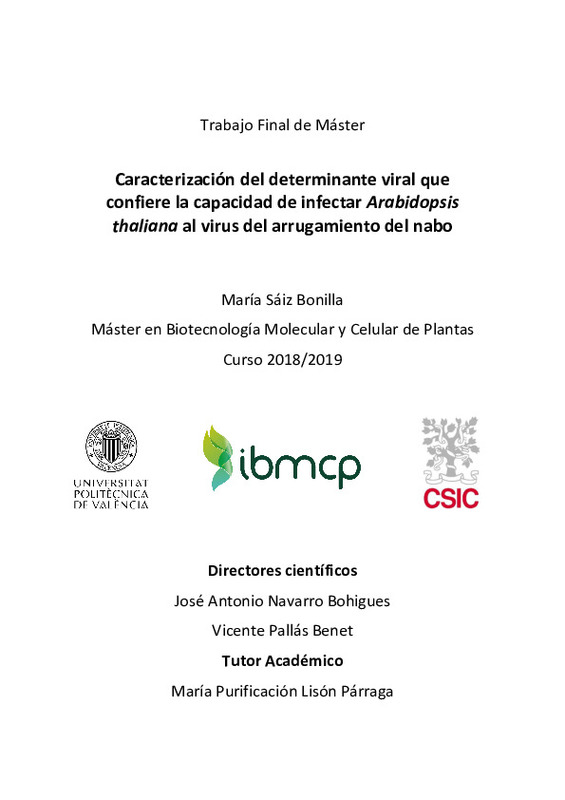|
Resumen:
|
[ES] Actualmente, los carmovirus se clasifican en tres géneros diferentes, en base a las relaciones filogenéticas de sus RNA polimerasas (RdRp): los Alfacarmovirus, cuyo miembro tipo es el virus del moteado del clavel, ...[+]
[ES] Actualmente, los carmovirus se clasifican en tres géneros diferentes, en base a las relaciones filogenéticas de sus RNA polimerasas (RdRp): los Alfacarmovirus, cuyo miembro tipo es el virus del moteado del clavel, CarMV; los Betacarmovirus; cuyo miembro tipo es el virus del arrugamiento del nabo, TCV; y los Gammacarmovirus, cuyo miembro tipo es el virus de las manchas necróticas del melón, MNSV. En general, estos virus presentan una gama de huéspedes naturales muy estrecha. Alfa y Betacarmovirus causan enfermedades principalmente en plantas ornamentales con flor mientras que los Gammacarmovirus infectan leguminosas, con la excepción del MNSV que se encuentra restringido a cucurbitáceas. Sin embargo, a nivel de huésped experimental, únicamente TCV, pero no CarMV ni MNSV, es capaz de infectar Arabidopsis thaliana sistémicamente, a pesar de que los tres miembros tipo presentan una organización genómica muy parecida. Todos los carmovirus se caracterizan por presentar un genoma simple, que consta de una molécula de RNA lineal monocatenario y de polaridad positiva, y de pequeño tamaño, aproximadamente 4 kb. Este se organiza, al menos, en cinco pautas de lectura abierta (ORFs), generalmente, solapadas entre ellas. A. thaliana se ha convertido en un organismo modelo para el estudio de diferentes aspectos científicos en plantas, entre ellos la interacción planta-patógeno. Un aspecto muy relevante de la Virología vegetal es dilucidar cuales son los factores virales que determinan la especificad de huésped. En el Trabajo Final de Máster que se describe en esta memoria se pretendió identificar el determinante viral que confiere al TCV la particularidad de infectar A. thaliana. Para ello, partiendo de clones infecciosos de los tres virus, ya disponibles en el laboratorio, se procedió a la obtención de construcciones recombinantes de MNSV y CarMV con diferentes factores o elementos funcionales de secuencia del TCV para, posteriormente, evaluar su capacidad infecciosa en A. thaliana. La obtención de variantes de MNSV y/o CarMV capaces de infectar A. thaliana facilitaría los estudios sobre la relación de estos virus con su huésped.
[-]
[EN] Currently, carmoviruses have been classified into three different genera, based on the phylogenetic relationships of their RNA polymerases (RdRp): the Alfacarmoviruses, whose type member is the Carnation mottle virus, ...[+]
[EN] Currently, carmoviruses have been classified into three different genera, based on the phylogenetic relationships of their RNA polymerases (RdRp): the Alfacarmoviruses, whose type member is the Carnation mottle virus, CarMV; Betacarmoviruses; whose type member is Turnip crinkle virus, TCV; and the Gammacarmoviruses, whose type member is Melon necrotic spot virus, MNSV. In general, these viruses have a very narrow range of natural hosts. Alpha and Betacarmovirus cause diseases mainly in ornamental plants while Gammacarmoviruses infect legumes, with the exception of MNSV that is restricted to cucurbits. However, at the experimental host level, only TCV, but not CarMV or MNSV, is able to infect A. thaliana systemically, even though the three type members have a very similar genomic organization. All carmoviruses are characterized by presenting a simple genome, which consisting of a linear single-stranded RNA molecule of positive polarity, and of small size, approximately 4 kb. This is organized, at least, in five open reading guidelines (ORFs), generally, overlapping among them. Arabidopsis thaliana has become a model organism for the study of different scientific aspects in plants, including the plant-pathogen interaction. A very important aspect of plant Virology is to elucidate which are the viral factors that determine the host specificity. In the Final Master's Project described in this report, we aimed to identify the viral determinant that confers TCV the particularity of infecting A. thaliana. For this purpose, starting from infectious clones of the three viruses, already available in the laboratory, we obtained recombinant constructions of MNSV and CarMV with different factors or functional sequence elements of the TCV and evaluated their infectious capacity in A. thaliana. Obtaining variants of MNSV and/or CarMV capable of infecting A. thaliana would facilitate studies on the relationship of these viruses with their host.
[-]
|







